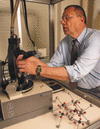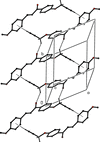issue contents
Jerry P. Jasinski tribute
Edited by David Manke and Matthias Zeller
This virtual issue of Acta Crystallographca Section E collects together articles originally published in tribute to Jerry P. Jasinski, a former Co-editor of Acta E, in earlier issues of the journal.

Cover illustration: Jerry P. Jasinski (1940-2021). Photo courtesy of Keene State College.
The life and career of Jerry P. Jasinski are celebrated in a virtual special issue.
Knowledge of space groups and the implications of space group symmetry on the physical and chemical properties of solids are pivotal factors in all areas of structural science. The tutorial contains > 200 PowerPoint `slides', in five modules, arranged by crystal class; a sixth module covers special topics. A `credits' module gives the direct addresses of all embedded links. In the tutorial, lattice points build iteratively and interactively with keyclick, and the coordinates of points `pop up' as the unit cell is filled.
`Symmetry and Space Group Tutorial' (by Jerry P. Jasinski and Bruce M. Foxman) provides chemistry students an opportunity to learn space-group diagrams through the peer-tutoring approach.
Download citation


Download citation


Two crystallographically independent molecules are present in the asymmetric unit. O—H⋯O, N—H⋯O and C—H⋯O hydrogen bonds form rings and chains and π–π stacks further connect molecules in the crystal.
CCDC reference: 1540679
Download citation


Download citation


[Rh(μ-I)(COD)]2 was found to crystallize as two different polymorphs in which the Rh dimer adopts either bent or planar geometries with respect to the Rh2I2 core.
Download citation


Download citation


The unsubstituted cyclopentadienyl ring is rotationally disordered while the other Cp ring and its substituent are close to coplanar. In the crystal, the molecules pack in `bilayers' parallel to the ab plane with the ferrocenyl groups on the outer faces and the substituents directed towards the regions between them. The ferrocenyl groups are linked by C—H⋯π(ring) interactions.
CCDC reference: 2101472
Download citation


Download citation


Five new bis(arylamide)dichloridozinc(II) complexes have been prepared and characterized. All of the complexes contain hydrogen bonds between the amide N—H group and the amide carbonyl oxygen atoms or the chlorine atoms, forming extended networks.
Download citation


Download citation


The reported molecule contains a number of unusual features, the most notable being a finite yet exceptionally long cyclic metal-azido chain. These rare features are the consequence of both sterically protecting Cp* ligands and highly bridging oxide and hydroxide ligands in the same system and illustrate the interesting new possibilities that can arise from combining organometallic and solvothermal f-block element chemistry.
CCDC reference: 2105511
Download citation


Download citation


(E)-1-(4-Methoxyphenyl)-3-[4-(prop-2-ynyloxy)phenyl]prop-2-en-1-one undergoes a cyclocondensation reaction with thiosemicarbazide to form the corresponding 4,5-dihydropyrazole-1-arbothioamide, which in turn undergoes further cycloaddition with phenacyl bromides to form 4,5-dihydro-1-(thiazol-2-yl)pyrazoles. The molecules adopt an overall T-shape structure. Different combinations of hydrogen bonds link the molecules into ribbons or sheets.
Download citation


Download citation


The crystal structures of two manganese(II) complexes have been determined. The manganese(II) centers of each structure are six-coordinate with a distorted octahedral geometry. Although the bis(quinolin-2-ylmethyl)ethanamine ligands differ only by a methyl group, the structure of one complex is dimeric with bridging acetate ligands and exhibits a trans coordination and coplanarity of the quinolyl moieties, while the second complex is monomeric with a cis coordination of the quinolyl groups.
Download citation


Download citation


A hydrogen sulfate salt, [BnSeCH2CH(Ph)NH3+](HSO4−), of a chiral selenated amine (R)-2-(benzylselanyl)-1-phenylethanamine (BnSeCH2CH(Ph)NH2) has been synthesized and characterized by elemental analysis,1H and 13C{1H} NMR, FT–IR analysis, and single-crystal X-ray diffraction studies. This selenated salt crystallizes as a monohydrate. In the crystal, several O—H⋯O and N—H⋯O hydrogen bonds and C–H⋯π and Se⋯O weak interactions result in a complex two-dimensional sheet-like supramolecular architecture.
CCDC reference: 2114403
Download citation


Download citation


The structures of 1:1 and 1:2 adducts of phosphanetricarbonitrile with 1,4-diazabicyclo[2.2.2]octane are reported.
Download citation


Download citation


The metallamacrocyclic core of the discrete hexanuclear 15-metallacrown-5 complex [TbCu5(GlyHA)5(H2O)6.5(SO4)]2(SO4)·6H2O contains five copper(II) ions linked by five glycinehydroxamate (GlyHA2–) dianions with a square-antiprismatically octacoordinate terbium(III) ion in the centre. The positive charge of the 15-metallacrown-5 [TbCu5(GlyHA)5]3+ core is compensated by bidentate and non-coordinated sulfate anions.
CCDC reference: 2121203
Download citation


Download citation


The X-ray crystal and molecular structures, DFT study and Hirshfeld surface analysis of a novel spirobicyclic diselenide are reported.
CCDC reference: 2127961
Download citation


Download citation


A tetranuclear complex with an open-cubane like structure was synthesized from 2-methoxy-6-(pyridin-2-yl-hydrazonomethyl)-phenol and characterized using micro-analytical and spectroscopic techniques, and single-crystal X-ray diffraction analysis.
CCDC reference: 2096266
Download citation


Download citation


The title Eu complex, featuring both Anthracac and trispyrazolylhydroborato ligands, exhibits an octavertex square-pyramidal coordination environment.
CCDC reference: 2143190
Download citation


Download citation


A cobalt sulfate complex supported by β-picoline ligands produces a unique cuboidal tetramer.
CCDC reference: 2143864
Download citation


Download citation


With cobalt(II) chloride, some piperazine- and homo-piperazine-derived ligands yield tetra- or pentacoordinate complexes. Observed variations in coordination number are ascribed as being related to chloride solvophobicity. Optical spectra are presented, while magnetism measurements indicate governance of the magnetism by zero-field splitting of the cobalt ion.
Download citation


Download citation


The reaction of [Cu(CH3CN)4](BF4) with 1-methyl-1,3-imidazolidine-2-thione {SC3H4(NMe) NH} forms the one-dimensional coordination polymer [Cu4(κ5:L1—N—S—N—L1)2(κ1:L1—NH)2(κ2: L1—NH)2]n(BF4)4n {L1 = SC3H4(NMe)NH} with sulfur-bridged {CuI4S10}n central cores.
CCDC reference: 2150195


 journal menu
journal menu



































